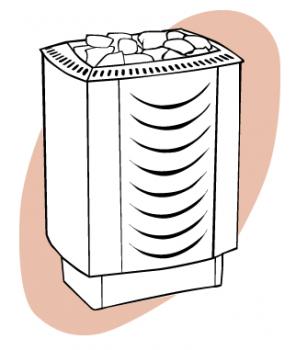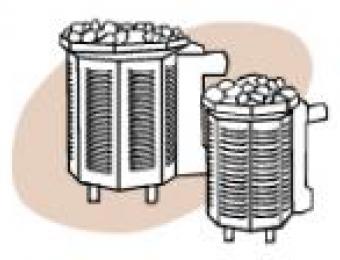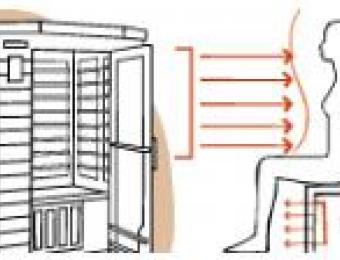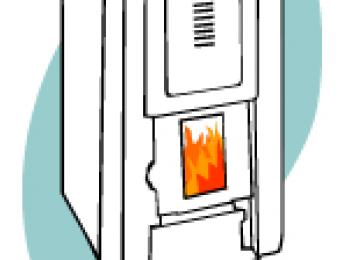Electric sauna heaters are the most common type of heater available, and as a result they're the type of heater that most people are familiar with.

How do electric sauna heaters work?
Electric, gas and wood fired sauna heaters all heat using convection. In an electric heater, electricity is passed through resistive elements. The resistance causes electric energy to be converted into heat energy, and as a result the elements heat up. Heat is then transferred from the heating elements to stones that are stacked on top of them. These stones store the heat, and consequently heat the air surrounding them. Direct contact between the heating elements and the stones ensures that heat is transferred as efficiently as possible.
When the stones are hot, water is gently added to them which instantly evaporates to create steam. This steam is circulated around the room, creating a hot, humid sauna enviroment.
How effective are electric saunas?
Electric saunas are slightly less responsive to thermostat adjustments than gas or Far Infra Red (FIR) sauna heaters due to the time taken for the elements to heat and cool. This is less of a problem in a sauna than it might be in something like an oven where precise temperature regulation is needed though, and is unlikely to have any great effect on the overall experience.
How powerful should my electric sauna heater be?
The most important thing to check for in an electric sauna heater is that it is powerful enough to meet your size requirements. Different sauna heaters are designed for different sized saunas. If you get one that's too small, it is unlikely to provide sufficient heat. Likewise, if it's too powerful, you may have a hard time keeping the temperature and humidity at a comfortable level, and you might end up spending more than you need to on electricity. Keep in mind that a bigger heater may be needed in colder climates or for a sauna with outdoor exposure.
The power of electric saunas is measured in terms of kilowatts (kW), however most manufacturers will also provide some indication of the area or sauna size that each model is designed to heat.
- As a general guide you will need about 1kW of power for every 1 to 1.5 cubic metres (m3) of area in your sauna. If your sauna's situated outside in a cold climate, it's a good idea to allow for 1kW of extra power.
In most residential applications, a moderate heater will be sufficient. If you're planning a larger sauna though, you will also need a larger heater, which in turn is likely to require the installation of 3-phase wiring. In either case, you will need an electrician to connect the wiring to the rest of the house.
Quality and materials
Most quality electric sauna heaters are made from stainless steel, aluminium or galvanised metal, and should be properly coated for effective rust resistance. It pays to be cautious about paint coatings on your heater. Over time, the extreme environment in the sauna may cause paint coatings to detach from the metal surface. This can quickly lead to corrosion of the metal underneath if it's not otherwise protected. Many higher end heaters forgo a paint coating and opt for stainless steel instead.
You may be understandably concerned about tipping a ladleful of water over an electric element - provided the stones are sufficiently hot though, none of the water will make it as far as the elements before it is turned into steam. Regardless of this, your heater should be thoroughly waterproofed to protect against accidents.
|
Advantages
|
Disadvantages
|





